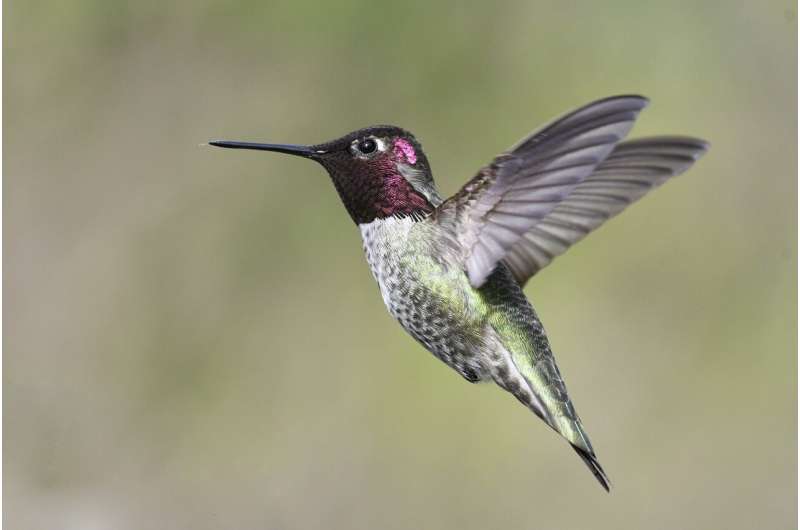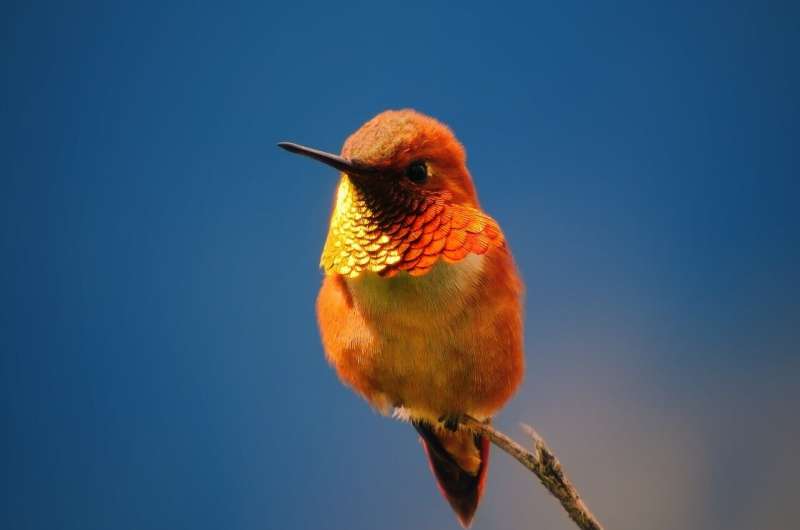This article has been reviewed according to Science X's editorial process and policies. Editors have highlighted the following attributes while ensuring the content's credibility:
fact-checked
reputable news agency
proofread
Hummingbirds are 'on the go' in California: What you'll see and how to attract them

Whether sipping nectar from flowers and zipping through the air, hummingbirds are a sure sign of spring in California.
The itty-bitty birds are busy breeding and building nests, which means there are plenty of opportunities to view them in action.
"They're very entertaining to watch," said Andrea Jones, senior director of conservation at Audubon California. "They're just on the go all the time. I think that's the funnest part—just watching them whizzing around."
Of the 16 species of hummingbirds listed in the National Audubon Society's Guide to North American Birds, six can be spotted in California, Jones said.
"Depending on the species, you'll always pretty much find a hummingbird somewhere except for high in the Sierra," she said.
Here are the kinds of hummingbirds you might see in the Golden State, how to identify them and how to attract them:
Which hummingbird species can I see in California?
If you see a colorful hummingbird darting through your garden, experts say, there's a good chance it's an Anna's hummingbird.
"Anna's is the most common hummingbird to see in California with the biggest range," Jones said. "They've really done a good job of taking advantage of backyard habitats. They're a lot more adaptable because of that."
Male Anna's hummingbirds are easily identifiable thanks to their "iridescent emerald feathers and sparkling rose-pink throats," according to the Cornell Lab of Ornithology's All About Birds site.
As with most bird species, male hummingbirds tend to be flashier and easier to spot than females.
You might also recognize Anna's hummingbirds due to the distinctive noises they make, including a song that sounds like a series of buzzes, whistles and chip notes.
"In their thrilling courtship displays, males climb up to 130 feet into the air and then swoop to the ground with a curious burst of noise that they produce through their tail feathers," the Cornell Lab said.
Torrey Gage-Tomlinson, program director for Morro Coast Audubon, described the sound as a "cross between a bird chirp and a referee whistle."
The Allen's hummingbird can also be spotted year-round in California, mostly on the coast.
Male Allen's hummingbirds have brilliant reddish-orange throats, orange bellies and green backs.
These birds also make elaborate moves to attract mates, the Cornell Lab said, "swinging in pendulous arcs before climbing high into the sky and diving back down ..."

Visually, Allen's hummingbirds share some similarities with rufous hummingbirds, which are rusty orange all over.
In the spring, rufous hummingbirds migrate through California on their way to their breeding grounds in the Pacific Northwest, British Columbia and southern Alaska. They swing back through the Golden State in the fall before wintering in Mexico.
You're more likely to spot a black-chinned hummingbird or Costa's hummingbird in desert areas.
Male black-chinned hummingbirds have black heads with shimmering strips of purple at the chin, the Cornell Lab said, while male Costa's hummingbirds boast iridescent purple throat feathers that jut out like "an overgrown mustache."
If you're lucky, you might spot a migrating calliope hummingbird, the smallest bird in the United States. Male birds sport rays of magenta feathers on their throats.
"This tiny little thing goes into Central Mexico and then goes all the way into Canada," Jones said. "They're considered long-distance migrants."
What are hummingbirds doing now?
Hummingbirds spend the first part of spring looking for mates and nesting materials—and establishing their territories, Gage-Tomlinson said.
"This is really the peak season for observing hummingbirds," he said, because they're so active.
They'll next start laying eggs and raising young, which happens in April and May.
Around May or June, the young hummingbirds will leave the nest, he explained.
In late summer, fall and winter, hummingbirds spend most of their time flitting from flower to flower as they feed.
"They're very important pollinators," Gage-Tomlinson said.
How can I attract hummingbirds to my garden or backyard?
Planting native plants is the best way to bring hummingbirds to your garden or backyard, experts say.
To find out which plants grow best in your area, check out the National Audubon Society's Plants for Birds database. Type in your five-digit ZIP code and you'll get a list of native flowers, grasses, shrubs and trees and the birds they attract.
In Northern California, the Audubon Society suggests planting species such as California figwort, scarlet monkey flower and white-leaf bush lupine to attract hummingbirds.
Suggestions for Central Valley residents include bladder-pod beeplant and cobwebby thistle, while Central Coast options include black sage, crimson columbine and chalk live-forever succulents.
Folks with limited outdoor space can hang up hummingbird feeders filled with a sugar-water solution, Jones said.
"My biggest suggestion is to not use food dye" because it's bad for birds, she said. "There's no need to introduce chemicals into their little tiny systems."
You'll want to clean your feeders regularly because they tend to get moldy, she said.
How else can I help birds?
Although you're unlikely to stumble upon a hummingbird nest by chance—"They're absolutely tiny," Jones said—you may notice nesting birds' behavior.
"If you start to see a bird going back and forth" from a particular spot, Jones said, "You need to stay away from it as much as possible. They're very susceptible to disturbance."
You should also keep pets away—especially your feline friends.
"The best option for cats and for birds is to keep the cats inside," Jones said. "They do a lot of damage to bird populations."
You can also help hummingbirds by providing them with clean drinking water, Jones said.
"You don't have to create a fancy fountain—just a low bucket with some rocks and water in it," she explained.
2024 The Sacramento Bee. Distributed by Tribune Content Agency, LLC.



















